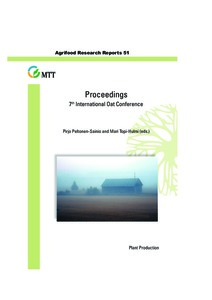Acceptability of oat varieties for the brewing process
Zarnkow, Martin; Back, Werner (2004)
Zarnkow, Martin
Back, Werner
Julkaisusarja
Agrifood Research ReportsMaa- ja elintarviketalous
Numero
51
Sivut
s. 208
MTT
2004
Tiivistelmä
Despite of a well kept tradition over centuries to use oat as malted raw material for wort and beer production today this brewing cereal has been displaced almost completely. Ten different oat varieties where examined for their acceptability as brewing cereals and malted. The most favourable sample has even been used to brew different types of beer in pilot scale. The pilot maltings of these samples have been done in a 1 kg scale with 45 % moisture content, isotherm at 14,5 °C (8 and 9 d vegetation time) and with a kilning temperature of 80 °C/3 h. The beer was brewed either in a 1,5 kg or a 10 kg pilot plant. In both cases a lauter tun was used for solid-liquid-separation. Hot break was separated with a whirlpool. The wort was pitched at 10 °C with top fermenting wheat beer yeast (< 5 % dead cells, methylenblue-test) which was been cultivated several times in oat wort. After three days of main fermentation a maturation step at 16 °C and a two week storage time at 0 °C followed. The resulting beers have not been stabilised or filtered. The varieties differed only little. The malt with the extended malting time of one day demonstrated better levels of enzymatic activities and modification. Therefore the batch which was used for the brewing trials was malted with nine day vegetation time. All ten oat varieties had low levels of extract caused by the high level of husk material, which requires quite high proportion of water for mashing. The high portion of fatty acids was degraded only to a small amount. The low foam levels could be explained by the presence of fatty acids since they are not assimilated completely by the yeast. In addition fatty acids have a negative effect on flavour stability. In comparison to barley malt oat malt have considerably lower levels of enzymatic activity. On this account the enzymatic rests during mashing where noticeable laboured. Saccharification and lautering took place in a fast way. Main fermentation, maturation and storage ran smooth and efficient. All three beer types produced (Schank-, Voll- und Starkbier) offered a pleasant top fermenting aroma which still differ from the familiar southern german wheat beer aroma. The trials demonstrate that the cereal oat does contain a potential to produce a drinkable pleasing beer.
Collections
- Julkaisut [85612]
